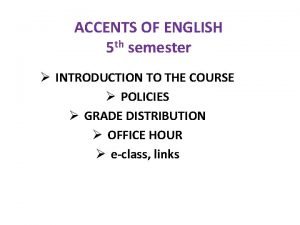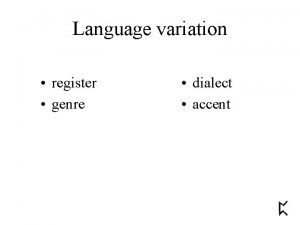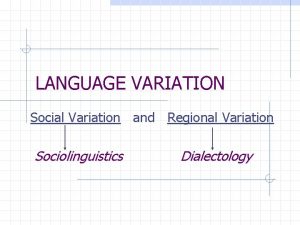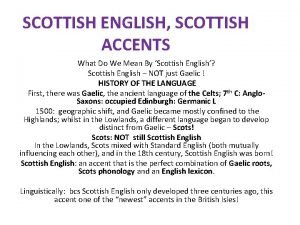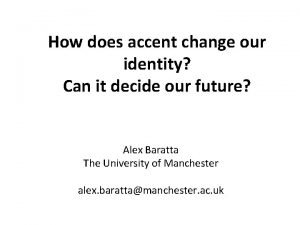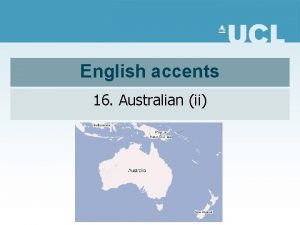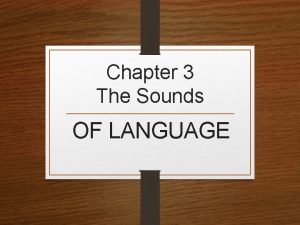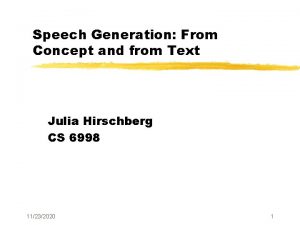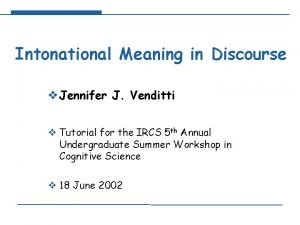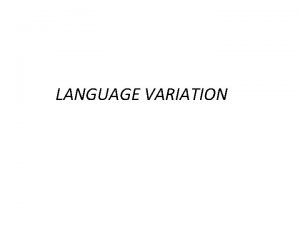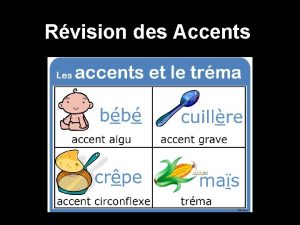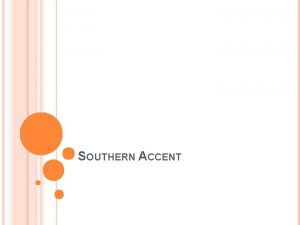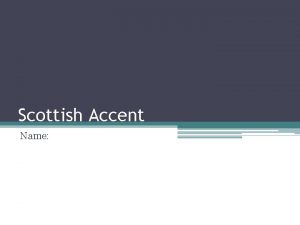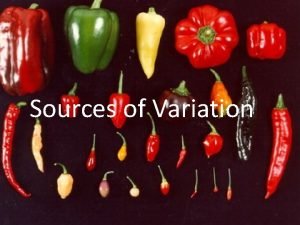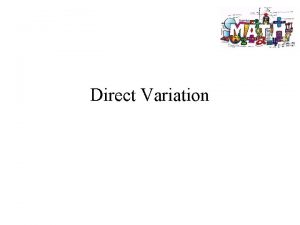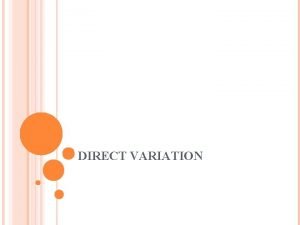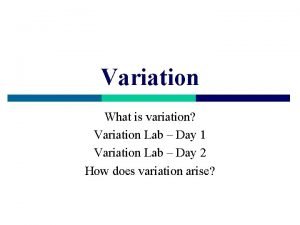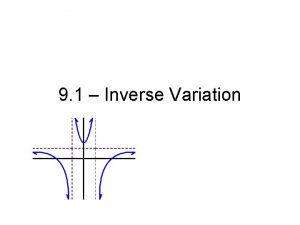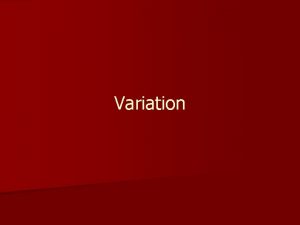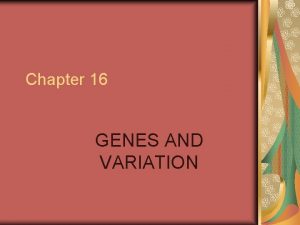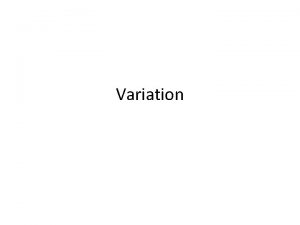Variation in Accent What is an Accent What





















- Slides: 21

Variation in Accent What is an Accent? What is the Model? How Does an Accent Vary? What are the Processes & Patterns for Variation? What are some Explanations/ What are the sociolinguistic variables that motivate Accent variation?

Received Pronunciation & Other Accents RP is the model accent. It is also called the Queen’s Accent or BBC English. Received Pronunciation is a prestigious accent that reflects social status ; it is endowed with positive associations. There are 3 types of RP: -- Mainstream RP: used as a model of in education and in the media. -- Conservative RP: used by the Queen & the older generation and is sometimes ridiculed in Britain itself for being an obsolete accent. -- Advanced RP: used by the younger generation pp. 260 -1

Definition • An accent is the set of sound qualities of a language; An accent is composed of the main segments of sound of a language / phonemes(consonants and vowels) and the prosodic features(suprasegmental features) such as intonation & rhythm mainly (plus voice quality).

Accents vs. Dialects • The difference between accent and dialect: accents consist of pronunciation dialects consist of grammar, word, meaning (and pronunciation) • Accents = pronunciation of consonants and vowels + patterns of intonation. • Historical linguistics: helps understand why some changes occur in pronunciation. Sociolinguistics: look at social variation in pronunciation. Important characteristics of speech delivery: stress and intonation. • Phonetics is the name given to the scientific study of the sounds of language; describing and analyzing sounds in a variety of ways.

Different types of Sounds • Fricative: pushing air through mouth when almost closed. f and s are called fricatives • Labial: pronounced by using the lips. (b, p) • Alveolar: tip of the tongue touching the alveolar ridge (t, d) • Plosive: the sound made when one suddenly stops his breath then let go. p and t are called plosives • Velar: pronounced at back of mouth. k and g are called velar

To study Variation in Accents – first examine Variation in: A) English Phonemes (sounds) To understand why accents vary –look at the range of distinctive sounds /phonemes , their distribution and how they are realized or pronounced. • Minimal pairs are pairs of words that have one phonological element that is different. Example: bat -- bet (p. 262) Accents vary at the level of the consonants and vowels with respect to: 1. The different phonemes they possess (Scottish English has /x/)/ the different pronunciation of vowels in different accents. 2. the distribution of these phonemes, or the different environments in which they occur (e. g. rhotic and non-rhotic accents) 3. The differences in how these phonemes are pronounced (or phonetically realized) e. g. clear and dark l (p. 266) • Tables 7. 1 and 7. 2 p. 262: display consonant and vowel phonemes in RP. • Pg 263—table 7. 3 contrast the pronunciation of the vowel sounds in words dad father, caught in RP, Scottish and South West American accents. .

• Rhotic/ non-prevocalic will pronounce an R when it is not followed by a vowel. like they will say ca. R ha. Rd wate. R ca. Rt but non rhotic/prevocalic will pronounce R only if it is followed by a vowel sound e. g. carry , Red, torrid , wate. Ry, but not in hard, car, water • (NOTE: vowel sound, not vowel letter. ) If it is followed by a vowel sound pronounce it like CARRY) ( In RP of English, Australia , New Zeland, and Singapore R can only occur after a vowel sound{ it must be pre-vocalic} • Most varieties of American, Scottish English, an R is pronounced wherever it occurs in the spelling, including at the end of words (car) or before another consonant (park) this use of nonprevocalic R is seen among the people of Singapore(Hollywood influence. US, Canadian, Irish, Scotland---Rhotic. Jamaican Variety is SEMIRHOTIC. R—pronounced if word ends with R – far car, R comes before a consonant –cart but not if it comes before a vowel—fare, tear. Further pronunciation of R which distinguish speakers in terms of age, social class (chapter 8) • (Peter Trudgill)Young speakers of Norwich – rabbit---wabbit

Phonetic Realization of “l” ‘L ‘ may be pronounced differently depending on its position in a word –in RP the L in leaf and feeling ( Clear)is different from l in feel(Dark ) • Laila is feeling sad she lost the leaf. (clear l) • “ I feel so sad. ” • Lancashire English speakers—use dark l no matter where , so do Americans & Australians. • Irish English uses clear l. • There also accents that use a vocalized “l”

B: Variation in Prosodic Features of English Accents: These are called supra-segmental features because they operate above the level of individual sound segments {vowels & consonants}--(they are sounds of sentences). • Rhythm = use of stress to mark syllables in an utterance. Intonation = change in pitch. • Intonation groups mark usually a break in grammatical structure: [When I went to London] [I wanted to go to the zoo] There is a “pre-head, a nucleus( the last stressed word in a sentence witnessing the major change of intonation , (and anything after the nucleus will be called the tail. ) Prosody is part of the system of language. (Pg 267) : After breakfast -- I went to class -- and took out my homework -- for the teacher. • Changes in prosodic features mark changes in meaning. Example: “ You may leave. ” or “You may leave. ” • • •

i) Examples of Rhythm pp. 267 -268 Accents could be stress-timed (RP English) – more time is given to stressed syllables. or syllable-timed (Singaporean) equal stress is given to each syllable. • a) No cat caught a mice. • No cat caught any mice. Roughly Same time elapses in spite of an extra syllable(any) • In syllable-timed Englishes ( Caribbean, Indian, Singapore ) same time given to each syllable. • Caribbean—notably Jamaican is ‘ Rhythmical’ because many words receive stress on the final syllable “celebrate” rather than initial stress as in RP –“celebrate” / doing whereas RP –initial stress – doing. In unstressed syllables Caribbean do not reduce vowel quality e. g. : the two syllables in police sound equal. --267 • p. 268 –Singapore—staccato (separated)effect-cutting off of successive words from one another+ equal length between to each syllable + glottal stop=wha not what

ii) Examples on Intonation • One accent in which a distinctive intonation feature has been studied is the Australian English. HIGH RISING TONE(HRT) or the Australian Questioning Intonation(AQI)— 269 -Guy and Julia Vonwiller study how (AQI) is used & why : motivational for attention & a conversational technique to mark a decision to continue holding the conversation. (HRT is also used in England in Tyneside, Birmingham Manchester, Glasgow) p. 269

iii) Voice Quality • Intonation patterns are tied up with the distinctive sound quality of voice (usually of individuals) e. g. nasal, breathless… • Linguists call the impression of a voice’s overall shape voice quality. • Voice quality is based on “the articulatory setting, ’ the physical arrangement of different parts of the vocal tract as people speak. ” (e. g. Australian accent is associated with AQI & nasal voice quality. P. 269

Regional Variation in Accent • Accents vary and change across geographical regions • Mapping regional accents: isoglosses Isogloss: is a separate geographical boundary for a relevant linguistic feature. An isogloss is a boundary marker, showing where one variant (a particular pronunciation, grammatical form, vocabulary item, etc. ) is used and not another. (p. 270) e. g. Jeddah (Saudi Arabia) & Egypt are an isogloss for the pronunciation of the ( )ﺝ as /g/ whereas Kuwait and Riyadh are an isogloss for the pronunciation of ( )ﺝ as /j/ or /z/

The Great Vowel Shift • It is a major change affecting the pronunciation of vowels in England from around the fifteenth century during the late Middle English period (roughly the period from Chaucer to Shakespeare). • What occurred was a systematic shift affecting the long vowels of English. They became ‘closer’ (i. e. articulated with the tongue raised higher in the mouth. Those that were already close (where the tongue could not move any higher) became diphthongs. ). According to linguist Otto Jespersen, who coined the term, "The Great Vowel. Shift consists in a general raising of all long vowels". See p. 272 table 7. 4. (e. g. /e: / /i: / as in sweet /i: / /schwa + i/ /a. I/ as in blind.

Examples on Great Vowel Shift • The i in Middle English had a long /e/ sound, as in the word sweet. After the Great Vowel Shift, one sees the long i sound pronounced as it is currently pronounced, such as in the word blind. • Example : the vowel in the English word date was in Middle English pronounced [a] (similar to modern dart); the vowel in feet was [e] (similar to modern fate); the vowel in wipe was [i] (similar to modern weep); the vowel in boot was [o] (similar to modern boat); and the vowel in house was [u] (similar to modern whose). • Innovative pronunciation followed the movement of the wealthy and influential people.

Mechanism of Spread of Variation A. Lexical diffusion (p. 273) • The vowels did not all begin to be pronounced differently at exactly the same time There is some evidence to suggest that the vowels in SWEET and MOON shifted before others did. It is also likely that vowels initially changed their form only in certain words and then in more and more as the new pronunciations spread through the language. • Chambers & Trudgill--Lexical Diffusion –Sound change originates in a single word/ a small group of words& spreads to all words in which it can be applied.

Mechanism of Spread of Variation (II) B. Regional diffusion (p. 273) • The Spread Of Accents from place to place The mechanism by which new pronunciations spread from community to community across the country is called Regional Diffusion. It depends on the movement of the people and the continuing contact between those on the move and the speech communities they pass through. (273) • vowel merger – when 2 vowels merge together to become one single vowel: the progressive merger of the vowels in words like (caught/ cot) in general American English. Read p 273 -274 (example of USA)275 (sociohistorical description of South African English illustrates interaction between social and regional factors (what is considered prestigeous, what is acceptable……. . Case of India…. • •

Example of Milton Keynes: • What happens when English speakers move from a number of different places & end up forming a new community –new town? Australian English , African English, … • New accents in new places—Milton Keynes & dialect leveling in S. E. British English (Paul Kerswill/ Reading B)—focused on age& gender Kerswill---younger kids follow parents’ pronunciation, children of older group(who mixed with others)—converge. He studied the sociolinguistic variables • Language change –geographical & social aspect of mobility. • It increased after World War II—leading to dialect leveling. Such mobility brought about rise of ‘new towns’ –e. g. Milton Keynes.

Social Variables/ Social Aspects of Accent Change • Social Class: William Labov- pioneer American sociolinguist studied the pronunciation of /r/ among New York subjects. He noticed that among the six social categories he studied, the upper class tended to most consistently use a rhotic accent (the accent viewed as most prestigious in the US). Hypercorrection: the tendency to apply a rule you are worried about making a mistake in where it doesn’t even apply. (e. g. using /p/ instead /b/ by an English speaker whose native language is Arabic. – or pronouncing the ‘ing’ at the end of ‘going’ while speaking while the general trend is to say ‘goin’ to make sure one’s accent sounds prestigious. Observer’s Paradox: The researcher needs to record the natural linguistic behavior of his/ her subjects, but because he is observing them they change their linguistic performance.

More Social Variables … • Ethnic Background: (includes influence of mother tongue) • Age/Gender (Guy & Vonwiller in Sydney Australia): • Social Network: Milroy & Milroy in Belfast Milroy overcame the observer’s paradox by getting well acquainted with her subjects that felt comfortable around her, and were mostly natural about their linguistic performance. • Horvath: (principal components analysis) this was an answer to the vagueness in Labov’s methodology which considered only one social variable – social class.

Evaluating Accents • Views about using Model English pronunciation. Examples from India (Kachru)p. 285 “Them & [uz]” poem by Tony Harrison p. 283 -4, including elements of IPA (international phonetic alphabet) & Harrison’s local vernacular. Examples of views in Ghana & Nigeria (p. 285)
 Direct variation
Direct variation Direct and inverse variation
Direct and inverse variation Prediction interval formula
Prediction interval formula Dialect vs accent
Dialect vs accent The king sits in dumferling toune accent marks
The king sits in dumferling toune accent marks Language
Language Greek syllables
Greek syllables Regional variation in sociolinguistics
Regional variation in sociolinguistics Glottal stop scottish
Glottal stop scottish Hr accent securex
Hr accent securex Accent and identity
Accent and identity New zealand vs australian accent
New zealand vs australian accent Dialect vs accent
Dialect vs accent Cockney accent where from
Cockney accent where from New zealand vs australian accent
New zealand vs australian accent Julia garber accent
Julia garber accent Bread and honey meaning
Bread and honey meaning 10 example of word stress
10 example of word stress Stress accent
Stress accent Regional variation meaning
Regional variation meaning Exploring microsoft office 2013 volume 1
Exploring microsoft office 2013 volume 1 Aigu grave circonflexe tréma
Aigu grave circonflexe tréma



